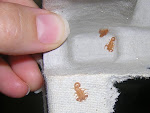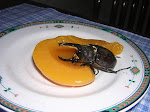
Almost unbelievably, subterranean termite casts could be seen along vertical cracks in the concrete wall of the kitchen. An uncapped sewer pipe somewhere in the building walls was breeding drain flies, which were accumulating -- dead -- in a kitchen sink below an overhead air vent. A container of "insect (dust) killer" was found in the custodial closet, likely applied liberally and at-will in classrooms. Throughout the elementary school my entomology colleagues and I were inspecting, the list of uh-oh's and no-no's was a mile long.
I was on my side under a counter reaching for a long-since-forgotten insect monitoring trap covered in kitchen grease, dead geckos, and insect feces. Jada was holding a flashlight and sat contorted around a floor drain apparently boasting its own flora and fauna. And my colleague, the biggest bug enthusiast among us, was picking black specks from a narrow space of floor between the refrigerator and wall, cradling them delicately in the folds of his big hands.
"Feces, we've got feces!" He shouted. It was like a cattle call. Stampede to the pest poo.
We three peered eagerly into his outstretched hand, like kids in a candy store. Jada eyed the black specs and whispered her deduction, "Tapered end.... sphincter. Mice. We've got mice!"
Some cockroaches have similar-looking poo as some mice, a quick tell between the two comes from the tapered end that mice produce. Cockroaches, along with other invertebrates, don't have anal sphincters as mammals do. ...Add that to the growing crib sheet, I thought. As an entomologist I already knew this of course, but outside the confines of a lab or classroom, wearing my pest inspection hat, bits of facts like this take on a whole new application, and are handy at-the-ready.
This is integrated pest management. Urban integrated pest management. It's purpose: to manage "bugs" (insects and their chitinous cousins), birds, weeds, and other unwelcome intruders in an eco-friendly way, relying first on non-chemical, practical methods and secondarily on least-toxic pesticides. Originally developed to manage agricultural pests, IPM today has a large and ever-growing contingency of entomologists and pest managers bringing the practice full form into our homes, offices, and schools. And I'm one of them. IPM is safe, effective, and works exceedingly well. And unlike the alternative, everyone has a part to play in the practice of it. As if all that weren't enough, IPM gives you bragging rights from knowing that your ecological footprint just got a little lighter.
We all know what the alternative looks like: when no one's around, the exterminator arrives to hose the place down and slap you with a bill. What IPM looks like is this: a bug geek crawling around on their belly to see the world from a bug's point of view, using sticky traps to piece together bug clues, drawing conclusions about the pest situation like a Sherlock Holmes murder mystery, and educating you about what pests are present, where they're occurring, and how they might have gotten there (i.e. what's attracting them). The pest expert will have a plan of action ready to propose, and it will likely involve you doing (or stop doing, in some cases) one or two very simple things to help discourage the bugs for good. Problem solved. Alternatively, you can continue with the "traditional" spray-and-pray approach... And you know, that method is working so darned well that, shoot, people always seem inclined to ask them back the next month to do it again. IPM or spray-and-pray? Tough choice. But people are slow to change, and as I mentioned in my Jan. 2 post, option "D" is still more prevalent. This baffles me, but that's a topic for another post.
IPM works because the techniques to deal with pests are based on known aspects of their ecology (behavior, life cycle, food, etc.). Solving bug problems with IPM methods hinges on the cardinal rules governing a bug's life: survive and reproduce (not unlike college frat boys). This is science-speak for food, water, shelter and sex. Pretty straight forward. So it's rare to come across a bug problem that is anything other than readily definable and fixable. People, on the other hand, pose much more of a roadblock. Try getting a teacher to regulate classroom food, or a kitchen manager to keep corrugated cardboard (aka roach airlines) out of the pantry. Try convincing the custodial staff to hang their mops and brooms, or atleast prop them head-up, or a busy principal to enforce IPM-friendly habits among their staff. Good luck! Honorable and overloaded, these folks are nevertheless tough to sell on the idea that everyone in a school has a role in IPM. It's not another job, we tell them; it's the same job done a little different.
*******
So to finish my story... Within two days of the elementary school's inspection, we produced a comprehensive report to the district administration and school principal identifying the pest issues alongside simple (cheap!) IPM solutions to each. 99% of their pest problems (and solutions) were in the hands of the school's various staff. The school had an awesomely proactive principal, and enthusiastic implementation of our ideas began almost immediately. But to the school district admin., the concept was nebulous. They limped along with the idea of going district-wide for less than half a year, and eventually backlogged it into ambivalence. We failed, pure and simple. We failed to connect with someone at a district level, someone with the power and pull to say "go!" and thereby positively impact the health of hundreds of students and staff. We failed to sell IPM for the long term cost-savings it brings, the energy-saving perks it offers, and the pest-reduction benefits it's so well known for. Or simply as "the right thing to do" for its own sake.
As entomologists, we nailed the bug problems. But in this particular case we failed at the "integrated" in integrated pest management.
+reduced.jpg)


1 comment:
Great blog, JP! I've added yours to mine as a reciprocal link.
Post a Comment